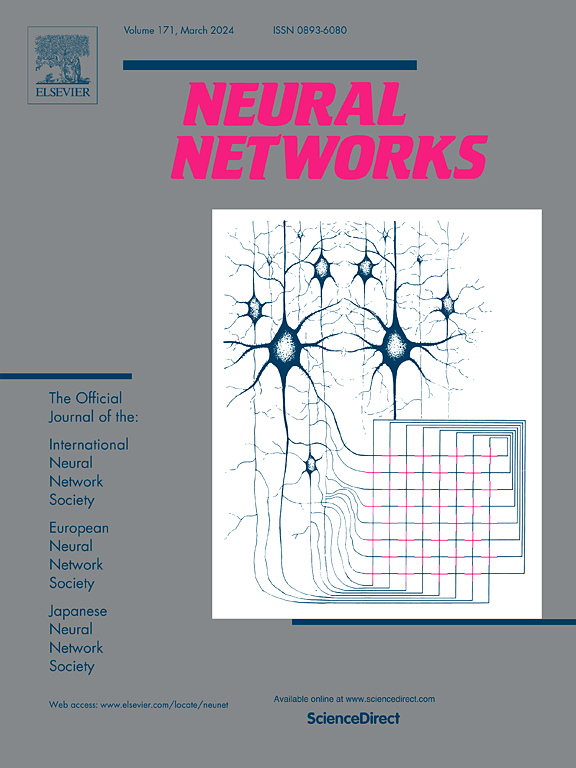基于相互纠错和知识融合的改进双视图交互模糊学习
IF 6.3
1区 计算机科学
Q1 COMPUTER SCIENCE, ARTIFICIAL INTELLIGENCE
引用次数: 0
摘要
鼻咽癌(NPC)是一种恶性肿瘤,起源于鼻道后部,从软腭上方到喉部上部。由于鼻咽部位置深隐,单一影像学手段往往难以明确其复杂的邻接性。此外,其临床表现也存在一些差异和不确定性。虽然双视图模糊分类器可以有效地挖掘鼻咽部位置的隐藏信息,并表现出良好的分类性能,但现有的预测鼻咽癌的模糊推理往往源于无法重用片面规则。因此,本文提出了一种新的双视图相互校正和知识融合的模糊分类器(tvm - tfc),以解决利用成像手段对器官组织进行微调的挑战。首先,利用Kullback-Leibler散度(KLIC)从各个成像切片(即知识片段)中选择重要特征。其次,采用可解释的零阶Takagi-Sugeno-Kang (TSK)模糊分类器作为基本训练单元,同时获得满意的准确率和简洁的语言可解释性。第三,本研究从成像手段和器官的角度出发,对不同成像手段之间的决策所需信息进行微调,使不同视角的优势互补,改善决策信息,从而提高决策精度。最后,结合成像技术和器官的视角来获取决策知识。这些不同视角的决策优势被有机地整合起来,进行信息补偿,进一步优化决策信息。通过对CT和MRI数据的对比实验分析,证明了该分类器的优点。本文章由计算机程序翻译,如有差异,请以英文原文为准。
Improved two-view interactional fuzzy learning based on mutual-rectification and knowledge-mergence
Nasopharyngeal carcinoma (NPC) is a malignant tumor that originates from the back of the nasal canal from above the soft palate to the upper larynx. Because the nasopharyngeal location is deeply hidden, it is often difficult for a single imaging means to clarify its complex adjacency. In addition, there exist some differences and uncertainties in its clinical manifestations. Although two-view fuzzy classifiers can effectively tap into the nasopharyngeal location for hidden information and exhibit good classification performance, existing fuzzy reasoning for predicting whether or not a nasopharyngeal cancer often stems from the inability to reuse the one-sided rules. Therefore, a novel two-view mutual rectification and knowledge mergence Takagi-Sugeno-Kang fuzzy classifier (TVRM-TFC) is proposed here to address the challenge of using imaging means to fine-tune the organ tissues. Firstly, Kullback-Leibler divergence (KLIC) is used to select important features from various imaging sections (i.e., pieces of knowledge). Secondly, the interpretable zero-order Takagi-Sugeno-Kang (TSK) fuzzy classifier is used as the basic training unit to simultaneously obtain satisfactory accuracies and concise linguistic interpretability. Thirdly, from the perspective of both imaging means and the organ, this study fine-tunes the information required for decision-making between different imaging means, so that the complementary advantages of the different views may improve the decision-making information and thus increase decision accuracies. Finally, the perspective of imaging technology and the organ are merged to capture decision-making knowledge. These decision-making advantages from different views are organically integrated to compensate information and further optimize the decision-making information. The merits of the proposed classifier are demonstrated through comparative experimental analysis on CT and MRI data.
求助全文
通过发布文献求助,成功后即可免费获取论文全文。
去求助
来源期刊

Neural Networks
工程技术-计算机:人工智能
CiteScore
13.90
自引率
7.70%
发文量
425
审稿时长
67 days
期刊介绍:
Neural Networks is a platform that aims to foster an international community of scholars and practitioners interested in neural networks, deep learning, and other approaches to artificial intelligence and machine learning. Our journal invites submissions covering various aspects of neural networks research, from computational neuroscience and cognitive modeling to mathematical analyses and engineering applications. By providing a forum for interdisciplinary discussions between biology and technology, we aim to encourage the development of biologically-inspired artificial intelligence.
 求助内容:
求助内容: 应助结果提醒方式:
应助结果提醒方式:


